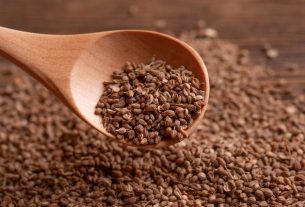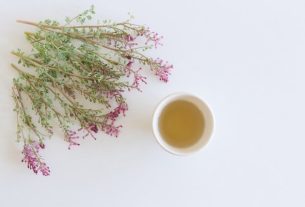Some options for home remedies for polycystic ovary are medicinal plant teas, such as yellow uxi tea, cat’s claw tea or fenugreek tea, as they contain substances with anti-inflammatory, antioxidant, analgesic or hormonal regulating properties. , which help alleviate the symptoms of polycystic ovary, regulate the menstrual cycle or even help you get pregnant.
In the case of yellow uxi and cat’s claw teas, it is very common to combine the consumption of these teas, taken at different times throughout the day, to enhance the immunostimulating and anti-inflammatory properties of both medicinal plants, and must be prepared separately and taken at different parts of the day, yellow uxi tea in the morning and cat’s claw tea in the afternoon.
Home remedies for polycystic ovary can only be used to complement the treatment recommended by the gynecologist, which normally includes the use of contraceptives. Furthermore, these teas must be used with medical advice, and are contraindicated in the case of suspected or confirmed pregnancy. See the main treatments for polycystic ovary.

Some home remedy options for polycystic ovary are:
1. Yellow uxi tea
Yellow uxi tea, prepared with the medicinal plant Endopleura uchi, is a great home remedy for polycystic ovary, as it is rich in tannins, saponins and coumarins, especially bergenin, with anti-inflammatory and hormone-regulating properties, which help alleviate the symptoms of polycystic ovary syndrome and stimulate ovulation. Check out other ways to stimulate ovulation and increase your chances of getting pregnant.
Ingredients
- 1 tablespoon of yellow uxi peel;
- 1 liter of water.
Preparation mode
Place the yellow uxi peels in water and boil for about 3 to 5 minutes. Then cover and let it rest for 10 minutes. Strain and drink 2 to 3 cups a day.
To drink yellow uxi tea associated with the consumption of cat’s claw tea, it is recommended to drink 1 cup of yellow uxi tea in the morning, and 1 cup of cat’s claw tea in the afternoon.
Yellow uxi tea should not be used by pregnant women, as it may interfere with the fetal formation process, nor by breastfeeding women.
2. Cat’s claw tea
Cat’s claw tea, made with the medicinal plant Uncaria tomentosa or Uncaria guianensis, It is a good option for a home remedy for polycystic ovaries as it has anti-inflammatory properties and also stimulates ovulation. Learn more about the cat’s claw plant.
Ingredients
- 1 tablespoon of cat’s claw;
- 500 mL of water.
Preparation mode
Place the ingredients in a pan and bring to a boil. Once boiled, cover and let it rest for 10 minutes. Strain and drink tea in the afternoon.
Cat’s claw tea should not be used by pregnant or breastfeeding women, or by people with illnesses such as lupus erythematosus, multiple sclerosis, kidney disease or leukemia. Furthermore, this tea should not be used by women who have blood clotting problems or who are taking anticoagulant medications.
3. Fenugreek tea
Fenugreek tea, prepared with the medicinal plant Trigonella fenugreek can help alleviate symptoms associated with polycystic ovary syndrome by regulating levels of the hormones LH and FSH, which helps reduce the size of cysts, normalize the menstrual cycle and improve fertility.
Furthermore, fenugreek also has anti-inflammatory properties that help alleviate the pain caused by polycystic ovaries. Learn more about fenugreek.
Ingredients
- 1 teaspoon of fenugreek seeds;
- 250 mL of cold water.
Preparation mode
Combine the ingredients in a container and let it rest for at least 3 hours. Then turn it into a pan and let it boil for 5 to 10 minutes. Finally, the mixture must be strained and allowed to cool. This tea can be taken up to 3 times a day.
Fenugreek tea should not be used by pregnant women as it can stimulate uterine contractions and induce labor. This tea should also not be used by women undergoing hormone-sensitive cancer treatment, such as breast cancer, for example.
4. Agnocasto tea
Agnocasto tea, made with the medicinal plant The chaste lamb’s vineis rich in flavonoids, diterpenes and glycosides, which have an action on the female hormones LH and FSH, helping to restore hormonal balance.
Therefore, agnocasto tea can be used to help regulate menstruation in cases of very long intervals between periods, or absence of menstruation, caused by polycystic ovary.
Ingredients
- 1 teaspoon of agnocasto fruits;
- 300 mL of water.
Preparation mode
Add the agnocasto fruits and water to a container, and heat for 3 to 4 minutes. Then cover and let rest for 10 minutes. Strain, wait for it to cool and drink up to 2 cups a day.
Agnocasto tea should not be used by women undergoing hormone replacement therapy, taking oral contraceptives or sex hormones.
Agnocasto can also be used in the form of capsules or tablets sold in pharmacies, drugstores or compounding pharmacies. Find out how to use agnocasto capsules and tablets.
5. St. Kitts herb tea
São Cristóvão herb tea, made with the plant of the species Cimicifuga racemosahas isoflavone and caffeic and salicylic acids, with anti-inflammatory, analgesic and antioxidant properties, which help regulate the menstrual cycle, promoting menstruation and relaxation of the uterus, making it a good home remedy option for polycystic ovaries.
Ingredients
- 1 teaspoon of dry St. Kitts herb root;
- 1 cup of boiling water.
Preparation mode
Place the dry root in a cup of boiling water and let it rest for 10 minutes. Strain and then drink 2 to 3 times a day, for a maximum period of 6 months to 1 year, as it can cause liver damage.
St. Christopher’s wort tea should not be used by women who are pregnant, breastfeeding or taking anticoagulant medications. Furthermore, this tea should not be consumed by women who have been diagnosed with breast, uterine or ovarian cancer, heart problems such as arrhythmia, low blood pressure, liver problems or seizures.
This tea can interfere with the action of the contraceptive pill and can also cause side effects such as stomach pain, liver problems or the formation of bumps on the skin.
6. Marjoram tea
Marjoram tea, prepared with the medicinal plant Oregano marjoram, can help regulate menstruation, as it has properties that help improve insulin resistance, which is common in polycystic ovaries. See the main causes of polycystic ovary syndrome.
Ingredients
- 20 g of marjoram leaves;
- 1 liter of water.
Preparation mode
Bring the water to a boil and when it is boiling, turn off the heat and add the marjoram leaves. Let it rest for about 10 minutes, then strain and drink up to 3 cups a day.
The use of marjoram is not recommended during pregnancy or for girls up to 12 years of age, as this plant can lead to hormonal changes that can influence the baby’s development or the girl’s puberty.
7. Saw palmetto tea
Saw palmetto tea contains fatty acids and phytoestrogens that can help promote the correct functioning of the ovaries, which can help regulate the menstrual cycle, making it a good option for a home remedy for polycystic ovaries.
Ingredients
- 1 tablespoon of saw palmetto powder;
- 1 glass of water.
Preparation mode
Add the saw palmetto powder to the glass of water and mix until the powder is completely dissolved. Drink 2 times a day.
Saw palmetto tea should not be used by pregnant or breastfeeding women, or by women with blood clotting problems such as hemophilia, liver diseases such as liver failure or pancreas problems such as pancreatitis, for example.
8. Green tea
Green tea, scientifically known as Camellia sinensishas phenolic compounds in its composition, such as epigallocatechin, which has antioxidant and anti-inflammatory properties, helping to reduce inflammation in the ovary and damage caused by free radicals in ovarian cells, making it a good home remedy to help treat the ovary polycystic.
Additionally, consuming green tea can help improve female hormone levels and reduce insulin resistance, which is common in polycystic ovary.
Green tea can be used in the form of teas, infusions or natural extract, and should be used under the guidance of a gynecologist as excessive use can harm the liver.
Ingredients
- 1 teaspoon of green tea leaves or 1 green tea bag;
- 1 cup of boiling water.
Preparation mode
Add the leaves or green tea bag to the cup of boiling water and let it steep for 10 minutes. Strain or remove the sachet and drink immediately. This tea can be consumed 3 to 4 times a day, or as advised by your doctor.
Green tea should not be consumed by pregnant or breastfeeding women, or those who have insomnia, hyperthyroidism, gastritis or high blood pressure.
Furthermore, as it contains caffeine in its composition, you should avoid drinking this tea at the end of the day or in quantities greater than recommended as it can cause side effects such as insomnia, irritation, a burning sensation in the stomach, tiredness or heart palpitations.
9. Ginger tea
Ginger, scientifically called Zingiber officinalishas phenolic compounds, especially gingerol, which has antioxidant, anti-inflammatory and immunomodulatory properties, being very useful for relieving the symptoms of bloated belly, nausea and cramps caused by polycystic ovary.
Ingredients
- 1 cm of ginger root, cut into slices or grated;
- 1 liter of boiling water.
Preparation mode
Bring the water to a boil and add the ginger. Let it boil for 5 to 10 minutes. Remove the ginger from the cup and drink the tea in 3 to 4 divided doses throughout the day.
Another option for making tea is to replace the root with 1 teaspoon of powdered ginger.
Ginger tea should be avoided by women who use anticoagulants, such as warfarin or acetylsalicylic acid, as it may increase the risk of bleeding or hemorrhage. Furthermore, women with clotting problems or who are at risk of bleeding should avoid using ginger tea.
10. Angelica tea
Angelica tea, prepared with the medicinal plant Angelica sinensis (Dong quai), is a good home remedy option for polycystic ovaries, as it helps regulate menstruation, improve blood flow to the reproductive organs, stimulate the uterine muscles, improve ovarian function and even fertility.
Ingredients
- 20 g of angelica root;
- 800 mL of boiling water.
Preparation mode
Add the angelica root to the boiling water and let it rest for 10 minutes. Then strain and drink 1 cup about 3 times a day

Sign up for our newsletter and stay up to date with exclusive news
that can transform your routine!
Warning: Undefined array key "title" in /home/storelat/public_html/wp-content/plugins/link-whisper-premium/templates/frontend/related-posts.php on line 12
Warning: Undefined array key "title_tag" in /home/storelat/public_html/wp-content/plugins/link-whisper-premium/templates/frontend/related-posts.php on line 13




